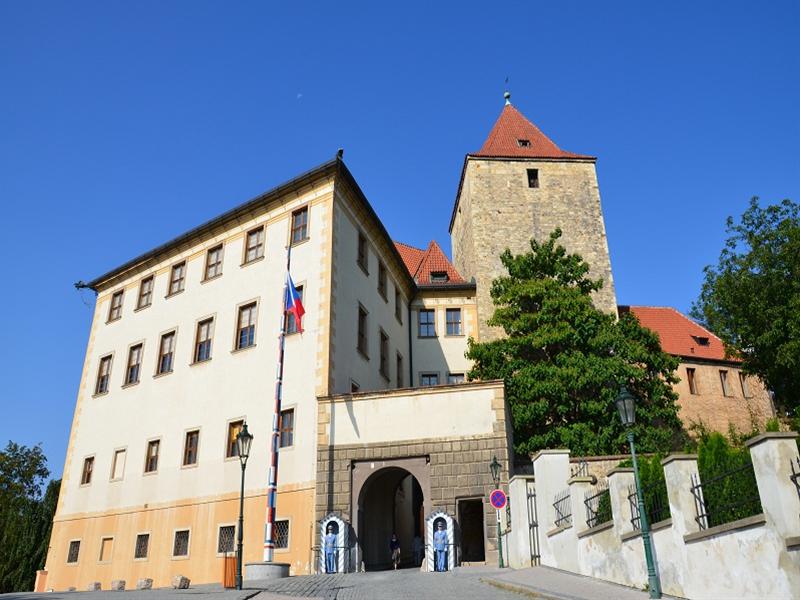
No two cultural institutions are ever the same, but there are often many similarities waiting to be found just beneath the surface. In this short essay, one of our student ambassadors has crafted a case study which compares and contrasts The McMullen Museum to The Lobkowicz Palace in Prague.
By Ileana Lobkowicz
My family returned to Prague in the early 1990s to reclaim and restore a vast, centuries-old collection of objects and properties that were confiscated twice in the 20th century—first by the Nazis and later by the Communists. The Lobkowicz Palace Museum opened in 2007, featuring paintings by Canaletto, Pieter Breugel the Elder, and Velázquez; a collection of arms and armor, and ceramics. Also on view are musical instruments and original scores and manuscripts by many of the greatest composers of the 18th-19th centuries, including Haydn, Mozart, and Beethoven. A family-narrated audio guide leads visitors through the museum’s 22 galleries and offers a personal perspective into European history.
The McMullen Museum of Art is the university art museum of Boston College, founded in 1993 under Director and Professor of Art History, Nancy Netzer. Since its founding, it has housed over 60 innovative exhibitions compiled by research teams of scholars and faculty worldwide. The museum recently moved to its newest Brighton Campus location, which opened in September of 2016, dwelling in what was the former residence of Boston’s cardinal archbishops. With the aim of fostering transdisciplinary collaboration, the new space has been brought to life with a number of student events, lectures, and conferences.
The McMullen and The Lobkowicz Palace Museum are most comparable in their educational initiatives, serving not only as art institutions, but also as cultural centers for learning. The McMullen offers a number of educational opportunities, including weekly public docent tours, workshops, and tailored programs for school groups. To fortify its bond with Boston College, the museum serves as a resource to enhance the undergraduate experience for students and educators—bridging classroom curriculums with art. One of the McMullen’s most recent initiatives is the Student Ambassador Program, which employs undergraduate students to engage with and promote the museum’s efforts, from using technology to enhance visitor engagement to conducting research on the permanent exhibition.
In addition to providing visitors with a free audio guide to learn about the history of the Collections, the Lobkowicz Palace Museum also offers specialized tours and programming for student groups to complement their areas of study. One such program is the annual Curator Challenge, an investigative project wherein students become “curators” tasked with discovering the purpose and provenance of uncatalogued objects from the Collections depository and Music Archive. In keeping with the mission of making the Collections accessible to the general public, the museum also hosts seminars and presentations on a wide range of topics—from music history to art restoration, prompting further discussion and interest for visitors.
In the dawn of their existence, museums were only used to display art. But today, there is a growing movement to redefine their purpose—as multi-functional venues. Honoring the entire architectural landscape of the gallery spaces in both the McMullen and The Lobkowicz Palace, both museums host a number of events, be it alumni reunions, corporate meetings, receptions, or weddings.
For example, the McMullen’s most popular student event series, Art After Dark, invites visitors for a night of food, dance performances, live music, crafts, and games—allowing people to interact with and explore the art housed within. The Lobkowicz Palace hosts a daily music concert in its Baroque concert hall, where those attending can take in its 17th-century frescoed ceilings while being musically accompanied by Mozart, Beethoven, and Dvořák.

While many cultural institutions share common goals and practices, there are differences that make each unique. One area where the McMullen and Lobkowicz Palace diverge is the frequency of their exhibitions. The McMullen changes its exhibits on a semester basis, where rotating temporary exhibitions define its curatorial programming. Months or even years of advanced preparation and research go into the installation process, which is just as quickly disassembled to prepare for the next exhibit. As each theme changes, so does everything involved in its assembly: light alterations, repainted walls, new catalogue designs. This quick transformation requires adaptability, attentiveness, and strategic planning in order to stay interesting and relevant as a museum—something the McMullen continues to do with great success.
The Lobkowicz Palace, on the other hand, houses a permanent exhibition and thus demands a different approach to maintain its public interest. Since the museum remains largely unchanged (save for temporary exhibitions or occasional room expansions) the need to seek tools and creative ideas to enhance it is essential. The focus, then, is placed on developing new programming and opportunities around the exhibition to stay current, rather than physically changing the exhibition itself. The Lobkowicz Library and Archive serves as an endless well of knowledge and history, housing materials that haven’t been touched in decades or even hundreds of years—a catalyst for ongoing public enjoyment and scholarly enrichment.
Both museums seem to share a mutual commitment to preserve the interest in and importance of their respective collections. Efforts are focused on cultivating sustainable educational programming and scholarly research. Both institutions strive to be ever evolving, finding ways to engage audiences both young and old. Creating such immersive environments allows people to discover the inextricable link between history, art, and humanity.
My involvement at both the McMullen and the Lobkowicz Palace has provided equally enriching experiences—ones that underscore the creativity, dynamism, and vision that seems to form the core of a successful museum.
